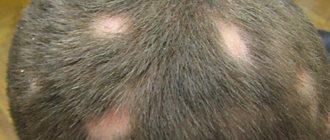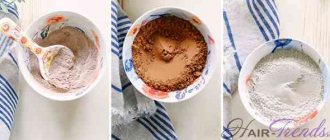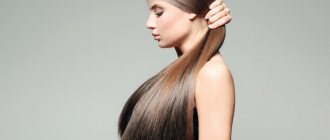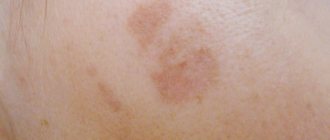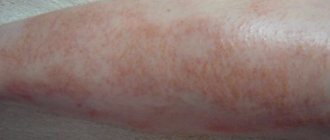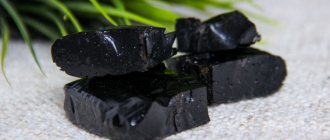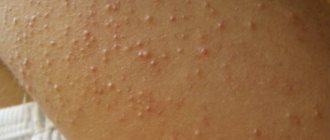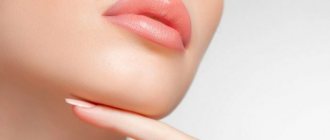From this article you will learn:
- How does alopecia areata manifest in women?
- What types of alopecia are there?
- What are the stages of alopecia areata in women?
- What are the causes of alopecia areata in women?
- How to diagnose alopecia areata in women
- How is alopecia areata treated in women?
- What are the ways to accelerate hair growth after alopecia areata in women?
- Is it possible to completely cure alopecia areata in women?
- What preventative measures exist to prevent alopecia areata in women?
Alopecia areata in women (baldness) is a problem that can occur at any age, but primary symptoms are often observed in women aged 15–35 years. Most people eliminate this disease in one or several years, but it happens that the disease becomes chronic, then it worsens constantly.
Focal baldness does not affect the health of the body as a whole, but is a cosmetic defect in aesthetic terms. If the disease becomes severe, the consequences can be dangerous.
How does alopecia areata manifest in women?
Alopecia areata already by its name explains that damage to this disease occurs locally, and not throughout the scalp. Cluster-type baldness is characterized by the formation of one or more round or oval-shaped lesions. The skin at the site of the bald spot does not differ in color, does not itch, and there are no rashes on it.
In most cases, alopecia areata in women does not cause discomfort. The initial period of the disease is characterized by very rapid and profuse hair loss in a specific area. If the disease is concentrated in a small area of the head, it usually goes away on its own and does not require therapy. If several bald patches form at once or a relapse occurs, you should consult a doctor.
In men, women and even children, the disease manifests itself in the same way: there is continuous hair loss in a certain area. Several bald spots can form, and if appropriate treatment is not carried out, they can grow and join together.
Main symptoms of the disease:
- smooth surface of the skin, on which in some cases a barely noticeable fluff is visible;
- there is an inflammatory process in the area of hair loss;
- the bald area becomes oval or round in shape;
- very rarely there is itching at the site of hair loss;
- the affected skin turns red and wounds form on it;
- the hairs become very brittle and this causes areas to form as if they had been shaved.
Symptoms of alopecia areata
The manifestation of the disease is very noticeable, because it is hair loss in one or several areas of the head. In this case, you can lose hair in the face and body. Symptoms may also be:
- Small area of baldness. Most often in the forehead area (especially in women), it has an oval shape.
- Slight inflammation or smooth skin in the area of hair loss.
- Slight itching may occur. Severe pain is extremely rare.
- Most often there is one bald spot, less often 2 or more.
- Loss of eyebrows and eyelashes may occur.
- Almost everyone suffers from deformation of the nail plate.
Alopecia areata itself does not pose much harm to human health, except for possible psychological pressure due to loss of appearance. But visiting a doctor is necessary, since alopecia is often confused with lichen, and it is dangerous for others.
Alopecia areata and other types of baldness
The photo of alopecia areata in women presented below demonstrates the stages of development of this disease.
Alopecia areata in women manifests itself in one of the following forms:
- Local. Areas of the oval contour where excessive hair loss occurs are identified.
- Ribbon-shaped. It is one of the most unfavorable forms of the disease. A painful lesion, on which almost no hair grows, runs from the back of the head to the temples and resembles a ribbon shape.
- Subtotal. At the initial stage, it is expressed by small lesions, which women carefully hide. But after some time, the disease progresses, the lesions become larger and connect.
- Total. It is a uniform loss of hair over the entire surface of a woman’s head; loss of eyelashes and eyebrows can also be observed.
- Universal. Hair loss occurs throughout the body. This form of the disease can develop over decades, affecting new and new areas. It happens that hair grows in previously bald areas, but at the same time new pathological foci form. From time to time, short-term remissions occur, which almost always result in relapses. A woman experiences unpleasant sensations in the first months of the disease, then during an exacerbation they are practically absent.
- Alopecia areata. The pathological process of hair loss occurs very quickly, and the nail plates are involved in it. This type of disease is a complicated form that is difficult to cure.
Stages of alopecia areata in women
There are the following phases of the disease:
Phase No. 1. Progressive. Characterized by swelling of the skin in areas where hair is almost completely absent. Hyperemia almost always occurs, and inflammation may occur. There are complaints from patients about severe itching, tingling and burning sensations. There are very short hairs near the place where complete baldness occurred.
There is accelerated hair loss in areas adjacent to bald patches. In most cases, women notice this sign of baldness while combing, but it happens that it is detected when touching the hair. Hair follicles have a dystrophic shape, indicating problems.
Phase No. 2. Subacute. This stage is characterized by the rare appearance of foci of inflammation, which are quickly replaced by others. There may be no inflammatory reactions at all. In areas of baldness, pale skin and absence of areas with short hair lengths are observed.
Phase No. 3. Regression. On bald patches, hair growth occurs, which has a fine structure. In most cases they are light, then undergo pigmentation. Their appearance improves as they grow.
If alopecia areata in women is mild, there is no deformation of the nails. Signs of mild dystrophy of the nail plate are observed in less than 20% of affected women.
The nested and universal forms affect the nails of almost all patients. They become more fragile, ribbing appears in the structure, and a wavy pattern appears along the edges.
We can talk about the chronic course of the disease if typical symptoms appear for six months or more.
Recommended articles on the topic:
- How to choose a hairstyle based on your face shape and online
- Dry hair care
- Haircut for women over 50: tips for choosing and suitable options
Diagnostics
At the moment, there is no most accurate and reliable method that could reliably diagnose alopecia. At the first suspicion of this disease, the patient is sent for a consultation with a dermatologist and trichologist. Subspecialty specialists conduct a thorough examination of the skin and hair, eliminating or confirming the presence of causes and predisposition factors to the appearance of baldness. If necessary, additional consultation with a therapist, endocrinologist, neurologist, gynecologist or psychologist is possible.
To confirm or refute the diagnosis, you will need to undergo the following tests:
● General and biochemical blood test (can confirm the presence of an inflammatory process); ● Endocrine studies (determining the concentration of hormones of the thyroid gland, adrenal glands, ovaries, pituitary gland, hypothalamus, etc.); ● General X-ray of the head (to identify traumatic brain injuries) ● Serological diagnosis of syphilis; ● Testing the scalp for strength (compulsory); ● Skin biopsy (4 millimeters in diameter will be required for analysis) at the site of baldness for further microscopic examination.
Causes of alopecia areata in women
The origin of alopecia areata in women and the reasons for its appearance are almost impossible to establish accurately. However, there is a list of factors that can affect the onset of this disease:
- Heredity. Everyone knows that many diseases are transmitted this way. If there has been a tendency for excessive hair loss in the male line, there is a high probability of baldness in their children.
- Autoimmune processes. This is the case when the cells of the immune system themselves block hair growth or destroy it. However, the therapy that is used does not produce positive results, so this reason has not yet been proven.
- Infectious diseases. Serious illnesses that a woman has suffered can cause hair loss on all parts of the body. Various fungal infections of the skin can also cause this deviation.
- Stress. There are patients whose bald spots began to appear as a result of suffering a moral shock.
- Injuries and cuts. There are cases when a person hits his head and damages his hair and severely injures the follicles, which can subsequently shed hair.
Read material on the topic: Why hair falls out: 10+ possible reasons
Video about the disease
A specific case of alopecia areata in a woman is described in this video.
In addition to medication and physiotherapeutic methods, home remedies can help cure baldness. The most commonly used are nicotinic acid, onion juice and pepper tincture - products that help dilate blood vessels, improve blood microcirculation and start the process of renewal of scalp cells.
Recovery from alopecia takes a long time, but the prognosis is usually positive. The problem rarely comes back if treated promptly.
Diagnosis of alopecia areata in women
In most cases, an experienced specialist, after examining a woman, can immediately determine the type of alopecia. He may use a dermatoscope to confirm the diagnosis. In any case, the first step is to scrape the areas of hair loss to rule out lichen and other similar diseases. If a woman has signs of other diseases, for example, lupus or syphilis, then a blood test is also necessary.
After passing the tests, you also need to undergo an examination by related specialists to exclude diseases accompanied by alopecia areata:
- from a neurologist - to exclude the influence of psychological trauma and nervous stress;
- from an endocrinologist - in order to reduce the influence of the thyroid gland;
- at the pediatrician - exclude pneumonia, chickenpox, helminthiases;
- from a gastroenterologist - omit vitamin deficiency, gastroduodenitis.
Read material on the topic: Plasma therapy of the scalp
Prevention of hair loss
Situations where a man has lost a piece of hair or is experiencing gradual hair loss in patches on the head do not really need to wait to begin corrective action. If a man has a predisposition to alopecia areata, it is important to prevent the disease in advance. First of all, a man needs to give up bad habits, adjust his lifestyle, giving preference to active behavior.
Next, you need to create a balanced diet to saturate the body with all the necessary microelements. During the off-season, you can take courses of multivitamins, but they must contain retinoids. It is better to exclude any environmentally unfavorable conditions, be it hazardous work or living in a bad area. All emerging pathologies and diseases must be eliminated in a timely manner so as not to encounter chronic forms.
Treatment of alopecia areata in women
Alopecia areata in women cannot be completely cured on your own at home. Treatment can only be prescribed by a trichologist after determining the cause of baldness.
To fix the problem, a comprehensive approach is required, including:
- adjustment of immunity;
- providing a local irritating effect, which is aimed at increasing blood microcirculation;
- the use of physiotherapeutic methods of therapy;
- antiviral drugs.
To completely get rid of alopecia areata, a course of treatment is required that lasts at least two months. Usually, focal baldness completely disappears after six months - this time is enough for the hair to grow back.
Women subject to frequent nervous shocks should definitely use sedatives and B vitamins when treating alopecia areata.
Drug treatment for alopecia areata consists of:
- Taking immunomodulators;
- Using local remedies that dilate blood vessels and improve blood circulation;
- Taking a complex of vitamins.
Immunomodulatory drugs are required to be used in any case, for any cause of the disease. If alopecia areata in women appears due to infection or fungus, then taking specialized medications is additionally indicated.
Improving local blood circulation is an important measure for hair restoration. Having determined the causes of baldness, the doctor can prescribe drugs that have vasodilating properties: nicotinic acid, pepper tincture. In addition, specialized serums and lotions may be prescribed, which must be rubbed into the bald spot.
The most widely known drugs that are used to regenerate the structure and quality of hair:
- tablets “Pantovigar”, “Minoxidil”, “Nutricap”;
- vitamins “Vitrum Beauty”, “Merz”;
- Folten Pharma products.
Vitamin complexes for hair in the treatment of alopecia areata in women are also prescribed by a doctor without fail. The dosage is calculated by a specialist based on the cause of the disease and the patient’s intake of additional medications. Taking vitamin complexes is the easiest way of drug treatment. In this case, vitamin B6 must be present.
Physiotherapy for alopecia areata also effectively combats baldness in women.
Physiotherapeutic methods make it possible to:
- Dilate blood vessels and increase blood supply to the roots;
- Raise local immunity;
- Activate inactive hair follicles.
The course of treatment includes 10–15 procedures, which should be carried out daily or every other day.
Physiotherapeutic treatment comes in several types:
- hair cryotherapy;
- electrophoresis;
- darsonvalization;
- iontophoresis;
- galvanization;
- massage.
Selecting the appropriate method of physiotherapy is possible only after identifying the cause of baldness.
Cryotherapy is based on the use of liquid nitrogen to locally freeze defective areas of the scalp. It works pointwise, but over the entire diameter of the baldness area. During the procedure, the walls of blood vessels are strengthened, blood circulation is improved and dormant bulbs are activated. This method is completely painless.
Cryotherapy can effectively cope with alopecia areata in women in a short period of time. The only drawback of this treatment is the destruction of the hair structure. This occurs under the influence of nitrogen - healthy hair loses water and becomes brittle, so this method of treating alopecia areata should be carried out in combination with additional measures to nourish and strengthen the curls.
Electrophoresis and iontophoresis are two similar methods of physiotherapeutic treatment based on the effects of current. In this case, a medicine is applied to the bald patch, which, together with current pulses, penetrates into the deeper layers of the epidermis. Typically, doctors use nicotinic acid, which is known for its ability to dilate blood vessels and increase blood circulation.
Galvanization is also based on current exposure, but with this method the scalp is heated. As a result of the formation of heat, metabolic processes in skin cells are accelerated, blood circulation returns to normal and the functioning of the thyroid gland is improved.
The most accessible and no less effective method of eliminating alopecia areata in women is darsonvalization. Its main advantage is its accessibility, because darsonvalization can be carried out independently at home. The Darsonval device is sold in any pharmacy. The set includes glass nozzles of various shapes and purposes. To eliminate alopecia areata in women, a fungus-shaped attachment is needed.
The darsonvalization procedure is simple: you need to connect the device to the network and perform a massage with a fungus attachment for 10 minutes. The drug helps restore hair follicles and activate blood circulation. The course of treatment consists of 15 procedures.
A scalp massage performed by a professional also helps to successfully get rid of baldness. The procedure should be carried out exclusively in a specialist’s office. The duration of the massage is approximately half an hour, and the doctor affects the area of baldness and the cervical-collar area.
Contraindications: presence of cancer and infectious diseases, pacemakers, pregnancy.
If all methods of combating alopecia areata in women do not bring positive results, then the patient may be prescribed a hair transplant. This is a surgical method that is used for severe forms of the disease. Such operations are carried out exclusively in specialized medical centers. You can learn more about alopecia areata in women, its treatment and reviews about it from any available information sources.
Read material on the topic: Hair carving: photos, types, advantages and disadvantages
Preparations for oral administration
Depending on the reasons that caused focal baldness in a woman, the specialist selects medications. They help cure concomitant diseases and improve the general condition of the body. As a rule, patients are prescribed:
- anti-inflammatory drugs “Ibunorm”, “Indomethacin”, “Pirocam”, “Diclofenac”, etc. - eliminate the source of infection;
- metabolism stimulants “Cerebrolysin”, “Vinpocetine”, “Curantil”, “Taurine”, etc. – improve tissue nutrition and enhance regeneration;
- hormonal drugs “Eutirox”, “Tiro-4”, “L-thyroxine”, etc. - to normalize hormonal balance;
- sedative medications “Afobazol”, “Neurostabil”, “Elenium”, motherwort tincture, etc. – improve psycho-emotional state;
- vasodilator drugs “Sermion”, “Trental”, “Cavinton”, etc. – do not allow an increase in blood viscosity;
- nootropic drugs “Noobut”, “Nootropil”, “Phenibut”, “Lucetam”, “Piracetam”, etc. — eliminate vegetative disorders;
- vitamin complexes “Fitoval”, “Vitrum Beauty”, “Perfectil”, “Revalid”, etc. - saturate the body with essential vitamins and minerals, selected based on test results;
- immunomodulators “Anthralin”, “Cyclophosphamide”, etc. – suppress the body’s auto-aggression, used only as prescribed by a doctor!;
- glucocorticoids “Dexamethasone”, “Cortisone”, “Prednisone”, etc. – regulate the activity of the immune system, used only as prescribed by a doctor!
In severe cases of the disease, subcutaneous injections of corticoids into the head are prescribed. Many doctors also recommend that patients undergo mesotherapy cocktails.
Ways to accelerate hair growth after alopecia areata in women
There are various ways to restore hair after alopecia areata in women. Let's take a closer look at what folk remedies are used to treat.
Aloe juice
Aloe juice is endowed with biologically active substances and is a strong stimulant. It’s not difficult to get it: you need to cut a few leaves, wash them, then cut them into pieces of any shape and mash them. The resulting juice must be rubbed into the scalp and left for 2 hours, then rinse your hair with warm water. You need to remember that the most effective remedy is one that was prepared from a plant that has reached three years of age.
Nicotinic acid for hair
The principle of action of nicotinic acid (using the example of nicotinic acid for hair from Renewal):
- Activates dormant hair follicles;
- Stops hair loss;
- Endowed with keratin-restoring effect.
As a result of applying nicotinic acid to the scalp, the following processes occur that affect hair growth:
- the vessels of the peripheral network become wider;
- blood circulation improves;
- the supply of oxygen and microelements to the hair follicles is accelerated;
- internal metabolic processes in the hair roots occur faster.
All of these processes stop massive hair loss and stimulate new hair growth. A secondary effect of nicotinic acid is its participation in maintaining healthy hair pigmentation.
Mask with Panthenol
D-Panthenol is a pharmaceutical product containing a substance that in a woman’s body turns into pantothenic acid (vitamin B5). D-Panthenol has a restorative effect, is used for the rapid healing of burns, cuts, bedsores, and is also an assistant for patients who suffer from dermatitis, furunculosis and other skin diseases.
D-Panthenol exists in the following forms: shampoo, cream, ointment, spray and gel. The last two types are widely used as scalp masks, which help speed up hair growth. A spray or gel, for example, should be applied to the roots of wet, clean hair and left for 10–15 minutes, then rinsed. Treatment of hair along the entire length allows you to smooth it and eliminate static electricity.
The use of D-Panthenol is limited for people who suffer from bronchial asthma, because spraying the spray can trigger an attack. Also, the active ingredient D-Panthenol can penetrate the placental barrier, so pregnant women are allowed to apply it only to very small areas of the skin.
Rinse with cold water. The effect of contrasting temperatures has a positive effect on the blood supply to the scalp and activates dormant hair follicles. So it is recommended to rinse your hair with cool (but not cold!) water. You can carry out this procedure after washing your hair, applying a mask or conditioner.
Apple cider vinegar rinse
With constant use of apple cider vinegar, hair growth increases, hair elasticity increases, shine appears, and combing becomes easier. Also, adding acid to the rinse water helps completely remove detergent residue.
You can get a very good hair rinse by dissolving apple cider vinegar in cool water in a ratio of 1 tbsp. spoon of vinegar per 1 liter of water. The resulting product is also used to fix hair color. For this purpose, brunettes and brown-haired women are recommended to supplement each liter of solution with a glass of rosemary decoction, and blondes - with chamomile decoction.
You should not rinse this natural rinse out of your hair: apple cider vinegar does not have a strong, intrusive aroma. Hair treatment with vinegar rinse is carried out once every two weeks. The most effective way is to use homemade vinegar.
Egg white nourishes the scalp, accelerates hair growth and prevents the occurrence of alopecia areata in women. Preparation of the mask: beat the whites of two eggs into a weak foam, then apply the resulting mass to the entire surface of damp hair. To increase effectiveness, you can wrap your head in a towel. After 10 minutes, rinse off the mixture with water at room temperature. You should make a mask no more than once a week. A positive result is observed after 3-4 procedures.
Egg-cognac mask
It strengthens the scalp and hair roots. Preparation: take 2 eggs and 30–40 ml of cognac. The mixture should be lightly whisked, then rubbed into the scalp, and after 15 minutes, rinse with cool water. Adding two teaspoons of olive oil to this mask will make your hair manageable and elastic.
Mask with essential oils
A mixture of equal parts of essential oils of jojoba, rosemary, lavender, thyme and almond, which is diluted with any vegetable oil in a ratio of 1:10, has a positive effect on the hair follicles. This mask is applied to the head and left for two hours. To completely remove this composition, you will need a well-foaming shampoo.
Spice mask
Ginger, cinnamon, mustard and hot red pepper activate hair growth by warming the scalp and stimulating peripheral blood flow.
The following compositions have the greatest effect: a mixture of alcohol tincture of red pepper and vegetable oil in equal proportions (oil can be replaced with liquid concentrate of vitamin A or E); pepper tincture, which is diluted with water in a ratio of 1:2; two tablespoons of dry mustard powder mixed with an identical amount of water, one yolk and two tablespoons of sugar.
For dry hair, you can add one tablespoon of vegetable oil or full-fat kefir to the mask; colorless henna with the addition of a pinch of cinnamon; a mixture of one glass of kefir, two teaspoons of vegetable oil, two yolks and a quarter teaspoon of dry ground ginger root.
All masks that contain spices, to varying degrees, cause a burning sensation. This effect is typical for compositions with red pepper and dry ginger. The irritating sensations of heat from mustard masks are directly proportional to the amount of sugar added to them (the more sugar, the higher the pungency). For this reason, these products should be selected based on individual tolerance; they should be applied exclusively to the hair roots.
It is recommended to keep this mask for 20–40 minutes (until the burning becomes severe). You need to rinse off with cool water. If the mask contains fatty components, you must use shampoo.
All of the above methods are aimed at treating alopecia areata in women at home.
Read material on the topic: Useful vitamins for hair: against hair loss and for growth
Treatment
To get rid of alopecia areata, complex measures are used, which consist not only of medication, physiotherapy, and, if necessary, surgical therapy, but also of providing all possible psychological assistance to the patient. It is important to have a complex effect on the entire body, as well as the use of drugs that normalize hair growth processes at the local level.
Cosmetic correction of alopecia areata
Conservative treatment
Often the progression of alopecia areata can be stopped even in severe stages of the disease using modern medications. The goals of drug therapy include not only gradually stopping hair loss, but also accelerating its growth, even in large areas of hair loss.
One of the most popular conservative drugs is Spironolactone . Sold in tablet form. With a course of treatment, hair loss can be completely stopped. If the disease is detected in the initial stages, use the drug for a month according to the instructions. When severe areas of hair loss are observed, the course of treatment is 3 months or longer.
When alopecia areata is detected, doctors often prescribe Minoxidil . The drug is available in liquid configuration. This medicine is distributed to areas where hair is completely absent. It must be applied twice a day. The course of treatment is no longer than 3 months. This drug allows you to normalize the condition of the follicles and ensures rapid hair growth.
Drug treatments for alopecia
If the disease has recently become apparent, it is advisable to use Finasteride . This medicine allows you to get rid of small areas of hair loss. To get a pronounced result, you need to use this drug 2 times a day. The dosage is selected after consultation with your doctor. If the drug is prescribed in the wrong dose, the symptoms of the disease may worsen. An overdose is unacceptable, as it can cause thinning of healthy hair and accelerate hair loss.
On a note! When used correctly, the drug is highly effective and allows you to completely cure diseases, but is contraindicated during pregnancy and lactation.
Cimetidine is popular . It is characterized by antiandrogenic properties, which is why it is prescribed exclusively for the treatment of baldness in women.
Video - Why do women go bald?
Local preparations
When alopecia areata is detected, it is necessary to accurately identify the cause of the disease in order to carry out proper treatment. In some cases, doctors look at several factors obtained from taking a patient's history. Features of treatment depend on the form and stage of the disease. To quickly get a positive effect, topical medications are used.
Doctors often recommend using specialized shampoos. The most popular of them are Fitoval, Rinfoltil, Alerana . Often companies provide separate lines of care products designed for people of different genders. When choosing a suitable cosmetic product, you need to pay attention to the type of hair for which a particular option is intended. Shampoos are used to accelerate hair growth and improve the structure of follicles. Cosmetic products often contain various vitamins and extracts from medicinal plants.
Alerana line of anti-hair loss products
On a note! Pay attention to the presence of such important components as poppy seed oil and lecithin. The first is necessary to normalize the hair structure and accelerate regeneration processes. This component also helps get rid of dandruff and has a positive effect on the appearance of hair. Lecithin helps improve hair structure by accelerating metabolic processes.
For complex treatment of alopecia areata, ointments are often used. In the initial stages, Fluorocort . It belongs to the group of glucocorticoids, which is why it should be used with caution, under medical supervision. The ointment affects the structure of blood vessels, increasing their permeability. The drug is applied to areas where almost complete hair loss is observed. Medicinal components accelerate the flow of nutrients into the follicles, which normalizes the hair growth process. The ointment is distributed onto the affected areas in a small layer.
Fluorocort drug
The product must be used 2 times a day. If the process of treating baldness begins in the last stages of the disease, you can use an ointment in the form of a compress. To note a positive result, it is necessary to carry out a course of treatment that is at least 3 weeks. On the recommendation of a doctor, it is often increased. With regular use of the ointment, side effects sometimes appear, which are unpleasant for patients, but do not always pose a great danger.
Itching, hyperemia, and other symptoms of skin irritation may occur. It is undesirable to use the ointment for fungal diseases; pregnancy is a relative contraindication for use. Do not use the drug if you are hypersensitive to certain components. When symptoms of alopecia areata are detected, women are often prescribed topical ointments.
On a note! In mild stages of the disease, Ultralan and Locacorten . If baldness spreads to a large part of the head, Lokoid and Flucinar .
The drug Lokoid for the treatment of alopecia areata
Is it possible to completely cure alopecia areata in women?
It is quite difficult to completely get rid of alopecia areata in women. The etiology of the disease is very important. Let’s say that temporary hair loss due to vitamin deficiency or a fungal infection is completely cured in a short time. If you have a hereditary form of alopecia or baldness that is caused by stress, it is very difficult to overcome the disease, even using medications.
In general, alopecia areata does not affect a woman’s ability to work; the psychological factor plays an important role. Many people lead a closed lifestyle due to the disease, which puts even more psychological pressure on the person and leads to a worsening of the pathology.
In order to avoid such problems, alopecia areata should be prevented.
Read material on the topic: How to care for your hair: a guide to action
Source of the disease
Alopecia areata is a long-term, recurrent pathological process during which hair follicles are affected. Trichologists (scalp and hair health specialists) believe that the cause of the disease is a malfunction of the immune system. Normal hair follicles become a “hostile agent” for the immune system and it attacks them to get rid of “foreign formations.”
At the same time, science still cannot explain the difference in the course of the disease and find out why only certain parts of the hair are affected.
It has been established that the triggering factors for baldness can be:
- genetic predisposition;
- stress, depression;
- frequent ARVI;
- use of certain medications;
- curls and hairstyles that damage the hair structure;
- any chronic infection: adenoiditis, sinusitis, sinusitis, etc.;
- disruptions in the functioning of the endocrine system organs: thymus, adrenal glands, pancreas, etc.;
- disorders of the autonomic nervous system;
- blood thickening.
Interestingly, alopecia areata is more common in women who have naturally dark hair - blondes practically do not suffer from the disease.
Prevention of alopecia areata in women
If you notice excessive hair loss, make an appointment with a trichologist and find out the reason. The best prevention of alopecia is to eliminate the cause of hair loss, especially if we are talking about the appearance of signs of internal diseases. Stress can lead to alopecia, so timely consultations with a psychologist when necessary, as well as taking sedatives, are very important.
Avoiding low-quality shampoos and conditioners that contain aggressive chemicals that promote hair loss can also be considered a prevention of alopecia areata. A very good preventative measure is to rub castor or burdock oil into the scalp weekly immediately before washing it.
If there is a problem with hair loss, it is not recommended to style with a hairdryer, curling iron, or hot tongs; you should not use curlers that weaken the hair follicles. Sudden temperature changes that occur when leaving a room outside without a hat have a negative impact on hair. A significant role in the prevention of alopecia areata in women is played by proper nutrition on a regular basis, thanks to which the follicles are provided with all the necessary vitamins and microelements.
To prevent worsening alopecia, you should consume B vitamins at regular intervals, as well as mineral complexes that contain iron, zinc, and calcium; it is not recommended to use hot styling products or use a comb with rounded teeth.
A good prevention of focal baldness is regular massage of the scalp, which helps to increase blood microcirculation, as well as periodic courses of using special medicinal strengthening shampoos.
Measures to prevent alopecia areata in women must be taken during pregnancy and (if there is a genetic predisposition) during adolescence.
For workers in chemical production and other hazardous industries, preventing alopecia is very important, since there is a possibility of damage to the scalp with the formation of scar tissue, because the follicles in this place can no longer work.
How do preventive measures against baldness work? Prevention of hair loss is based on strengthening the hair follicles, which are capable of producing healthy hair, as well as preventing external damage to the scalp.
One of the main measures to prevent alopecia areata in women is the general health of the body, because the well-established functioning of the digestive system helps supply the hair roots with vitamins and minerals, the psychological stability of a woman ensures the normal functioning of the nerve endings that are adjacent to the hair follicles, and the health of the cardiovascular system determines energetic microcirculation of blood in the scalp.
Hair loss tends to increase in the spring, when the scalp is too tired from heavy and tight hats, and the body suffers from a lack of vitamins and minerals. In addition, weakened immunity contributes to the exacerbation of most internal pathologies that can provoke the development of alopecia areata in women.
For this reason, with the arrival of spring, it is recommended to take as much care of your hair and scalp as possible, avoid traumatic perms, dyeing procedures, regular hot styling, eat well and take multivitamin complexes.
In addition, these days you no longer have to spend a lot of time performing complex and unpleasant procedures at home. It is much easier to seek help from real professionals - the Veronika Herba beauty and health center, equipped with effective and modern equipment.
Why clients choose Veronika Herba Beauty and Health Center:
- This is a beauty center where you can take care of yourself at a reasonable cost, while your face and/or body will be treated not by an ordinary cosmetologist, but by one of the best dermatologists in Moscow. This is a completely different, higher level of service!
- You can receive qualified help at any time convenient for you. The beauty center is open from 9:00 to 21:00, seven days a week. The main thing is to agree with your doctor in advance on the date and time of your appointment.
Sign up for a consultation with a specialist by phone 8 (495) 995-15-13
, and you will see for yourself!
Causes
Treatment of the nested form of baldness on the head cannot be effective and competent if the doctor has not determined the causes and factors that caused this pathological condition of the hairline. Despite the fact that it is impossible to predict and determine the exact causes of focal alopecia, there are still several common concomitant ailments that can be associated with subsequent baldness.
Trichologists name several of the most common factors for the occurrence of alopecia areata, namely:
- Immune system failure , when a pathological change in the activity of immune cells occurs, which perceive follicles as foreign bodies, attacking them. It is this autoimmune reaction of the body that most often leads to focal baldness, when hyperactive antibodies disrupt all processes near the hair roots.
- Vitamin deficiency , lack of B vitamins. Scientists have repeatedly proven how important endogenous retinoid vitamins are in the development of hair.
- Infections of internal organs or skin , parasitic infections. Various infections can provoke focal baldness, including mycoses, syphilis, psoriasis or seborrhea, etc.
- Trigger factors , that is, bad habits in men, anorexia, unfavorable living and working conditions, frequent hypothermia, hereditary diseases, as well as prolonged exposure to stress and depression. All this can lead to focal hair loss, after which this process will become systemic.
First of all, a man needs to pay attention to his lifestyle, nutrition and general well-being. Often, baldness becomes only a characteristic symptom of the clinical picture of a systemic disease, be it anemia, diabetes mellitus or even oncology, or it can be a hereditary factor transmitted through genes. Also, any surges in hormones and pathologies of the endocrine system can lead to hair loss.
